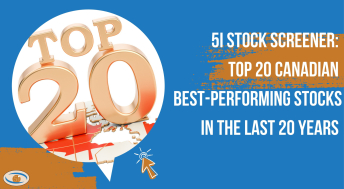It's hard enough these days just learning the most basic investment principles. What exactly a stock is, how the market works and how to achieve capital appreciation through disciplined long-term investing.
Now you have to pick and choose from a plethora of investment strategies to suit your needs and your risk tolerance? Talk about information overload.
There are a lot of investment strategies you can work off of to build the foundation of your portfolio. I'm going to tackle two of the most popular ways to invest today and let you determine if one of them may suit your needs.
Dividend Stocks – How could an income portfolio help me?
Investing in solid, blue-chip dividend stocks is one of the most popular investment strategies out there, and for good reason.
Why? Consider this, and I do this lots, let's turn to a quote by one of the most famous investors of all time, Ben Graham.
“An investment operation is one which, upon thorough analysis, promises safety of principal and a satisfactory return”
Companies that pay dividends, and have a long track record of doing so, are more than likely leaders of their industry. Their fundamentals are sound, they know how to turn a profit, and their business model simply works.
They have often exhausted most avenues for growth, and are now churning out dividends to their more than happy shareholders.
This isn't to say that dividend stocks are always safe. This definitely isn't the case. But in relation to growth stocks, they are considered the investment that promises a little more safety of principle.
In my opinion, every single investment portfolio should at least contain a foundation of blue-chip dividend stocks. Regardless of your risk tolerance, your portfolio needs some. The best of the best in terms of dividend stocks are going to be able to withstand a financial downturn better than most growth stocks.
So what exactly should I look for in a dividend stock that is different from a growth stock?
Well for one, and this may seem like a no-brainer, is the dividend itself. A company that pays an excellent dividend and has a consistent history of maintaining or increasing their payouts for a minimum of 10 years, in my opinion, is a stock worth looking at.
Secondly, you must look at the payout ratio, and this is an absolute. A company can theoretically pay out whatever the heck they want in terms of dividend payments. It doesn't mean they have the money to do so without going into debt.
I see a lot of new dividend investors simply looking for companies that pay ridiculous yields, thinking they will last forever. Well, if it seems too good to be true, it probably is. The company will either need to be accruing debt to maintain the current dividend payment, or simply slash it.
More times than not, if I see a payout ratio of over 60%, I run for the hills.
Last but not least is something I have mentioned before. Look for companies that can withstand financial hardship. I avoid cyclical companies when I am looking for a long-term dividend stock to purchase. These are industries like the automobile industry, which seems to make an absolute fortune when times are good, but is severely crippled during a recession.
Industries that people need to purchase products from no matter how hard the times, are best. Sectors like banking, telecommunications, and utilities are prime examples. You're always going to need your bank account, your cell phone, and your electricity.
Growth Stocks – How could a growth portfolio help me?
Growth stocks are the main event of the evening. They are what draws the biggest crowd in the investing world because they offer the largest return.
The main difference between an income stock and a growth stock? More risk.
You're investing in a stock which is aiming to become an income stock one day. Ever heard the term “You've gotta spend money to make money”? Well, it applies directly to growth stocks.
Instead of paying out a dividend to its shareholders, growth companies simply dump profits back into things like research, acquisitions, and product development to grow their revenue and increase their bottom line.
What this brings with it is the possibility for exponential returns. But with the returns also comes more risk. For example, it's going to take you a heck of a lot longer to earn 10 times your investment with Royal Bank as it would an emerging tech company who is developing a new gadget that will turn the world upside down.
But on the contrary, you're more than likely never going to lose a massive amount of your investment investing in an incredibly stable income stock like Royal Bank. That tech company? Yeah, their product had horrible reviews, and was generally a flop. Considering it's the only leg they had to stand on, you may be out of cash.
The key to growth investing is to limit your risk by investing in companies that have a high likelihood of succeeding. However, as you've probably heard, the only things in life that are certain are death and taxes.
So what should I look for in a growth stock that is different from a dividend stock?
Well, first off, you need to look at the overall health of the company. This obviously is a crucial aspect in any sort of investment, but blue-chip dividend stocks generally have strong fundamentals.
Look at the company's current position in the industry they are in. Are they lagging in terms of sales and growth relative to their industry? How much debt are they taking on, and as time has passed, is the debt going down and the revenue up?
Secondly, the value of the stock is absolutely crucial. Chances are you aren't the first one to hear about this new popular stock. The problem I see a lot of people running into is snap purchasing the stock at any price point due to FOMO (Fear Of Missing Out).
You may have just made a massive mistake, because the prospective future of the stock may already be reflected in the price. If a stock is trading at 200 times its earnings, it may be time to take a step back and truly evaluate where the price of this stock is going to be in the future.
There is nothing worse than buying a growth stock that already has its earnings projections 5 years down the road reflected in the current price.
So what should I invest in, dividend, or growth stocks?
I get this question a ton, and I honestly never give a straightforward answer, because there isn't one. However, I do have a philosophy I tend to preach.
If you're a younger investor, it may be wise to allocate a larger chunk of your portfolio towards high potential growth stocks. And by high potential, I don't mean the latest pump and dump biotech stock you found on a trading forum. I mean high-quality growth stocks that are going to establish themselves as industry leaders one day. Why?
Well, when you're young, you often have a long working career ahead of you. Market fluctuations and being wrong about a stock are not the end of the world. You took your shot, missed, suffered a portfolio setback but in the end will recover.
If you develop a knack for picking profitable growth stocks in your younger years, it can have an exponential effect on your portfolio size as you get older.
This leads me to my next point, and that is the transition of your investment portfolio from growth to dividend stocks as you get older.
The reasoning is fairly simple. If you're a few years from retirement, what would be the worst thing that could possibly happen? A market crash or downturn.
Not only does this have a negative effect on the capital in your portfolio, but it may actually extend your working career far beyond what you want it to be. A portfolio of blue-chip dividend stocks will lessen the blow, and allow you to still follow through with your retirement goals.
Keep in mind that I don't advocate in any way going for a portfolio strictly made up of stocks. This is simply my opinion of what stocks should be in your portfolio at the time.
I hope I opened your eyes a little on the differences between these two popular investment models and how you can go about them. When in doubt, there is nothing ever wrong with contacting a financial planner to see how you should go about allocating your investment portfolio!
Dan Kent is a writer and co-founder of Stocktrades.ca. A DIY investor for 7 years now, Dan has a combination of dividend, growth and real estate investments in his portfolio and is looking to continually grow his net worth. You can check his website out at stocktrades.ca or follow him on Twitter at @Stocktrades_CA.
Have a question? Sign up for free to ask 5i's Research Team your top question, plus get instant access to Canada's top stocks, three model portfolios, and over 75,369 answered investments questions. Get your free 5i Research Trial here.





Comments
Login to post a comment.